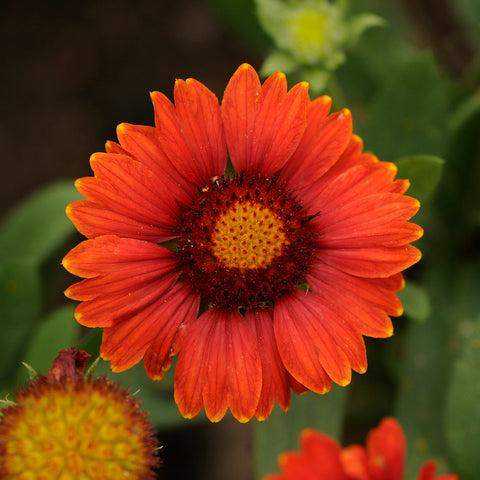Perennials are herbaceous plants known for thriving for three or more years. They exhibit a wide range of sizes, shapes, and colors, offering blooms from early April through late October, which contributes to their growing popularity. They are among the simplest plants to cultivate, suitable for various garden conditions, whether sunny or shady, clay or loamy, fulfilling nearly all gardening requirements.
PLANNING
Planning is crucial for creating a perennial garden. Gardens without a plan often lack direction and can appear chaotic in terms of color.
When planning your garden, several factors come into play, such as the garden's shape, viewing angles, whether it will be formal or informal, and the choice between beds or borders.
Once the layout and type of garden are determined, the next step is selecting suitable plants. Factors to consider include light and soil preferences, plant height, flowering times and durations, as well as flower colors. Other considerations may involve plant fragrance, suitability for fresh-cut or dried arrangements, and the plants' forms and textures.
After weighing all these factors, it's time to sketch out your garden on paper. A detailed plan provides a clear vision of how the garden will appear once planted.
BED PREPARATION
Bed preparation is one of the most important aspects in having a successful perennial garden. First, the bed should be dug to a depth of one foot. Next, one should decide what type of soil you have.
For clay soils, 10 to 15 cm of sand and peat moss should be added so the soil can drain properly. Adding gypsum (11 kg per 100 sq. ft.) helps break down the clay. If necessary, garden sulphur can be added to lower the acidity of the soil.
For sandy soils, add 10 to 15 cm of organic material (peat moss, manure, compost) to the soil to hold the moisture in the ground. When adding an organic material, also add a high-nitrogen fertilizer (urea 33-0-0) to help the material break down.
For peaty soils, add horticultural lime to raise the alkalinity of the soil, if necessary.
Finally, an all purpose fertilizer should be worked into the soil. A top dressing of mulch will keep the moisture in and the weeds out.
PLANTING
Planting perennials is a simple task, but the importance should not be overlooked.
There are two stages (dormant and active) in which perennials can be planted. Dormant plants are usually planted in the fall and active plants in the spring and summer.
Planting is a simple task. With a trowel, dig a hole slightly larger than the container in which the plant came. Place the plant in the hole at the same depth as the container (Remember to remove the container). Once in, firm the soil around the plants. Plants should then be watered in with a transplant fertilizer (high in phosphorous).
CARE
Perennials are relatively easy to care for, but they are not maintenance free. Watering, fertilizing, mulching and dividing are some of the tasks involved with the care of perennials.
Fertilizing should be done three times per year (spring, summer and fall) with an all-purpose granular fertilizer. Some perennials need more nutrients during the year and a water soluble general fertilizer should be applied. Watering of newly planted perennials should be done on a regular basis. More established plants should be watered only when there is a dry spell.
Bark, cocoa bean, needle and leaf mulches are some of the mulches used to cover perennials for the winter. Mulching can increase the survival rate of plants through the winter. Mulches provide a weed barrier as well as keeping moisture in the ground.
The dividing of plants is done for three reasons: to control size, to rejuvenate plants, and for the propagation of plants. Dividing is done in the spring and summer. When dividing in the spring, just divide those varieties that bloom in the summer and fall. Only those varieties which bloom in the spring should be divided in the summer.
A perennial garden can provide the homeowner with much enjoyment. Cut and dried flowers, perfumed scents and blooms from April to October are some of the rewards of growing perennials. With a little effort, one can enjoy a garden that blooms and grows for many years.
Hosta


Coneflower

Delphinium

Blanket Flower


Columbine

POPULAR PERENNIALS
The following is a comprehensive list of the most popular perennials. This list is arranged in alphabetical order, according to genus. Use the information provided, to plan your garden.
| Plant Name | Bloom Colour | Pant Size | Bloom Period | Exposure | Comments |
| Achillea (Yarrow) | Yellow-gold | Any | Mid-Late Summer | Full Sun | Well drained soil, may require staking |
| Alyssum (Basket of Gold) | Yellow | Low | Early Summer | Partial Sun | Well drained soil, divide in spring |
| Aquilegia (Columbine) | Blue Purple Yellow | Medium | Late Spring – Mid Summer | Sun/Shade | Well drained soil, divide late summer |
| Armeria (Thrift) | Purple Rose | Low | Late Spring – Mid Summer | Full Sun | Dry, infertile soil, divide every 4 years |
| Artemisia (Silvermound) | Silver Foliage | Low | Full Sun | Will adapt to poor soil conditions | |
| Aster | Rose Violet Pink | Medium | Late Summer | Full Sun | Water generously in well drained soil |
| Astilbe | Pink Red White | Medium | Summer | Partial Sun | Moist, fertile, organic soil |
| Convallaria (Lily of the Valley( | White | Low | Spring | Sun/Shade | Berries are poisonous |
| Chrysanthemum Maximum (Shasta Daisy) | White | Medium | Summer | Partial Sun | Fertile soil, divide every-other spring |
| Chrysanthemum (Hardy Mums) | Red Yellow Bronze | Medium /Short |
Fall | Partial Sun | Well drained moist soil, may transplant in fall |
| Delphinium | Pink White Blue | Tall | Summer | Full Sun | May require staking, cut back flowers after flowering |
| Dianthus (Carnation) | Pink Red Rose White Yellow | Medium /Tall |
Late Spring – Summer | Full Sun | Well drained alkaline soil |
| Dicentra (Bleeding Heart) | Pink to Fuscia | Medium | Late Spring – Late Summer | Partial Sun | Fertile soil, divide in spring or fall |
| Gaillardia (Blanket Flower) | Red Orange Yellow | Medium | Summer | Full Sun | Light, well drained soil, divide in spring |
| Gypsophila (Baby’s Breath) | White | Any | Mid Summer | Partial Sun | Well Drained, low nutrient, high pH soil |
| Hemerocallis (Day Lily) | Yellow Cream Bronze Pink | Medium | Late Spring | Partial Sun | Well drained organic soil, divide every 4 to 6 years |
| Hollyhock | Pink White Red | Tall | Late Summer | Full Sun | Well drained soil, may require staking |
| Hosta (Plantain Lily) | Lavender White | Medium | Summer | Partial Sun | Organic Soil |
| Iris | Assorted | Low /Tall |
Spring – Mid Summer | Full Sun | Divide rhizomes after flowering |
| Lillium (Lily) | Assorted | Tall | Summer | Partial Sun | Fertile soil |
| Lupimus (Lupine) | Assorted | Medium | Spring | Partial Sun | Cool, moist areas, acidic soil |
| Paeonia (Peony) | Assorted | Medium /Tall |
Spring | Full Sun | Shade inhibits flowering, establishment time, 3 years |
| Papaver (Oriental Poppy) | Scarlet Salmon | Medium | Early Spring | Full Sun | Well drained soil, difficult to transplant |
| Phlox Paniculata (Garden Phlox) | Assorted | Low/ Medium |
Summer | Partial Sun | Require fertilizing with Superphosphate or Bonemeal, divide in fall |
| Platycodon (Balloon Flowers) | Blue | Medium /Tall |
Summer | Partial Sun | Will not tolerate wet soil, does not transplant well, requires staking. |
| Primula (Primrose) | Assorted | Low/ Medium |
Spring | Partial Sun | Cool, moist, organic soil |
| Rudbeckia (Cone Flower) | Yellow Gold | Medium | Summer | Partial Sun | Easy to grow |
Landscape Ontario Horticultural Trades Association represents the leading garden centres in Ontario. As one of the select garden centres which has achieved “Approved Member” status, we assure our customers receive a high level of service, a good range of quality plants and associated products, together with professional advice and information.

